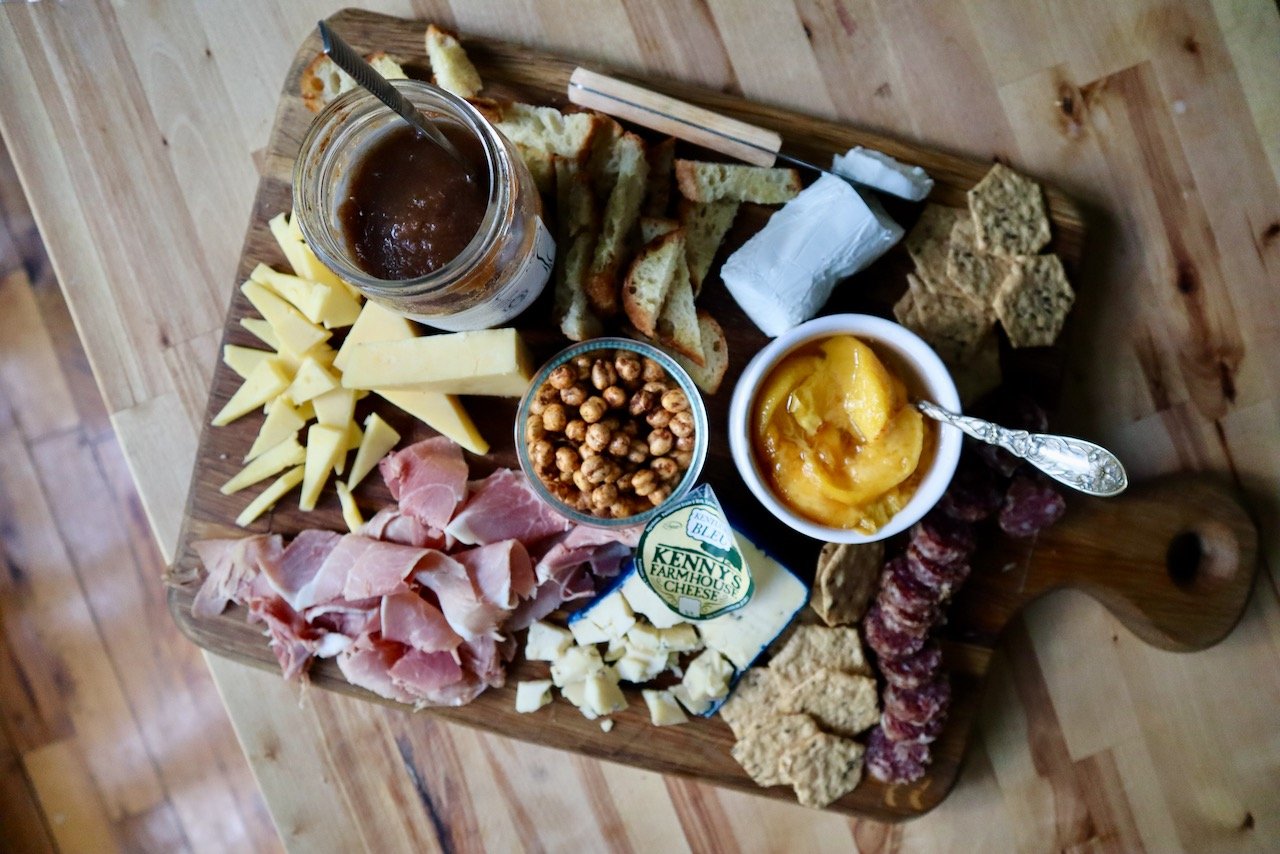Steve’s Botluck Tips
text by Steve Mancuso and Donna Hecker & photography by Talitha Schroeder
Members of our Holly Hill Wine Guild like to socialize with botlucks (like a potluck but with wine) so we asked Guild Director Steve Mancuso for advice on how to organize one. Here are Steve’s tips for hosting a fun time with wine and friends along with our notes on how we put them to work!
Wine-themed dinner parties are a great way to socialize with wine-curious friends. One way to organize your get-together is to have guests bring a bottle of wine to share. It’s a twist on the American cultural touchstone of potluck dinners.
The word “potluck” originally referred to one-pot communal meals where every cook brought something to add (“luck of the pot”). During the Great Depression, potlucks evolved into a meal where everyone brought a dish to share. They’ve become staples for churches and other community events, particularly in Appalachia.
The basic idea for our wine dinner – let’s call it a botluck (for bottle) – goes like this. The host provides the meal while guests bring wines to share and discuss after the meal, when the wines are tasted one-by-one.
Guest List – Let’s start with the size of your guest list. In general, the more the merrier would be true – but no more than 16 for a botluck because you’ll want every guest to be able to taste each wine. More than 16 people and the size of the pours are too small to enjoy. With a group size of 14-16, aim for around eight different bottles of wine to taste.
We invited our friends and co-workers to join us for a casual get-together and ended up with about a half-dozen guests. And a half-dozen bottles, so it worked out great.
The Meal – The host meal can be any type, from elaborate dinner to casual supper to picnic cookout. Just be sure there’s plenty to eat in the interest of sobriety. Save dessert for after the wine tasting.
We went with a holiday theme and did a deep dive into our recipe archive and the foodstuffs available in our online shop. Spiced pecans, cheese wafers, and country ham biscuits with apple butter were joined by a new favorite – homemade Boursin cheese seasoned with Chef Ouita’s hand-blended Bluegrass Herbs de Provence.
The Theme – The host selects a theme for the wines that are brought. The theme should be presented in the invitation. The theme can be simple, such as each guest brings a red wine. Another type of theme could be wines from a certain country (e.g. Italy or France) or region (e.g. Napa Valley, California or Bordeaux).
Color us quirky but we thought it would be fun to seek out unusual blends or varietals from a variety of unusual sources. Our challenge was to find good deals on interesting wines in a wide range of stores, from big box retailers to boutique shops. We found canned blanc de blancs and a Chilean red blend at CVS, a Greek varietal at Total Wine & More, a hard cider and wine blend at WiseBird Cider, a Bonarda-Barbera at Darling Wine Bar (sure to be a new favorite hangout), and a Chenin Blanc-Viognier at Walmart. All in Lexington and all proving the point that if you can’t make it to a wine store, you can still find interesting wines at a big box or chain drug store.
Price Range – The host should suggest a firm price range for the wines that guests bring to the party. This can avoid potential awkwardness or misunderstanding.
We set an average price point of $15 a bottle. Of course, some were much less and a couple were a little bit more but altogether we spent $88 on the equivalent of six bottles.
Supplies for the Tasting – You’ll need a wine opener, of course. There’s nothing wrong with asking guests to bring their own wine glasses. Wine charms or some way to identify whose glass is whose are helpful. You’ll want to provide water and light palate cleansers (crackers, cheese, etc.) for during the tasting.
We set the bottles up for self-service, with a wine key, water pitcher and dumping pitcher on a tray; along with a collection of our thrifted glasses. We’ve been haunting thrift stores for ages, especially as we outfitted the cooking studio. Those stores were our go-to for cast iron, vintage USA-made pottery, glass pitchers, linens, trays and dishware.
Tasting Sheets – This is optional. It’s nice for guests to have a list of wines they’ve tasted and a way to write their opinions. This requires a bit of coordination for the guests to communicate what wine they are bringing to someone designated to produce a tasting sheet. Suggest to guests they can bring pens if they want to take notes.
We used recycled kraft paper under each bottle for guests to write their notes on. If you have butcher paper, you could place the bottles on it and let it double as writing paper. We even toyed with the idea of sticky notes but were afraid they might not stick around for the length of the party.
The Tasting – Start with sparkling, then whites, followed by rosé, then red wines. Save sweet wines for last. Among the white and red wines, pour them in order of light to full- bodied based on their alcohol content. Meaning: Pour the 13% ABV red wines before the 15% ABV red wines. Allow about 10-15 minutes per wine.
The WiseBird Pommes Blanc was our lightest at 7.4%. Next was Coppola Sofia Blanc de Blancs, 11.5%; followed by Pine Ridge Chenin Blanc-Viognier, 12%; Seven Moons Red Blend, 13%; Nemea Agiorgitika, 13.5% and finally Cara Sur Bonarda-Barbera, also 13.5%. Because ours was such a casual get-together, folks just tasted at their leisure.
Choosing a Wine – Guests should adhere to the theme and price range. You’ll provide a short description of the wine as it’s being tasted. If possible, choose a wine that has a personal meaning to you. Maybe one from a winery you visited or enjoyed at a memorable restaurant meal. Stories make the wine (and overall experience) pop.
Make it a challenge and have fun with it! We really enjoyed getting outside our comfort zone and looking for unusual wines in unusual places.
Tipping the Host – Agree that guests will contribute a small ($10) amount per person to help defray the cost of hosting. Alternatively, guests could bring a bottle of wine as a gift for the hosts.
What about a Blind Tasting? – A blind tasting is where the identity of the bottle is hidden from the guests. Guests guess the specifics of the wine. I don’t recommend this unless your botluck group is made up of highly experienced wine drinkers. Blind identification is hard, even for trained professionals.
If you’re looking for a new way to enjoy wine with your friends, try a botluck! They are fun and a great way to taste and learn about new and delicious wines.
Steve’s right; we had a great time! Try it for yourself and let us know how it went. And if you’d like to explore the world of wine with like-minded enthusiasts, consider joining our Holly Hill Inn Wine Guild. Memberships for 2024 are now available!
Related Content
Building a Better Charcuterie Board
Who doesn’t love a good charcuterie board? It’s the perfect summertime/anytime way to feed a crowd or a couple of close friends. Before you go shopping, check out these tips from Chef Ouita Michel
© 2023, Holly Hill Inn/Ilex Summit, LLC and its affiliates, All Rights Reserved












